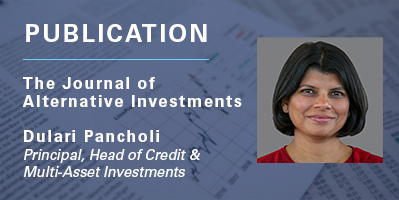Responsible Investor: Are European Fund Houses Coming for US Managers' ESG Lunch?
NEPC’s Endowment and Foundation Team Leader, Krissy Pelletier, was quoted in Responsible Investor to speak on how asset owners are thinking about sustainability considerations and its role in their manager selection. View the article on Responsible Investor’s site here.
US asset owners look further afield as local managers lose appetite for sustainability.
. . .
Krissy Pelletier, partner and head of endowment and foundation team at consultancy NEPC, says US asset owners are getting “more and more savvy and looking much further and much deeper”.
“Even investors who come to the table with strictly the investment-opportunity lens have gotten more savvy on digging deeper when there is a sustainability-minded find, asking questions about the expertise of the team or additional resources that a firm is utilising,” she adds.
. . .
According to Pelletier, there may have to be “hard choices” if underperformance of sustainable or ESG strategies impacts the spend rate of one of her clients or the work it is aiming to carry out.
However, she notes that many asset owners are being patient as some ESG strategies underperform and are willing to try and understand the underlying causes.
Click here to continue reading the full Responsible Investor article.
The Journal of Alternative Investments: Hedge Funds: Resolving Myths about ESG Integration
NEPC’s Dulari Pancholi‘s research paper was recently published in the Fall 2022 edition of The Journal of Alternative Investments. Her research examines the top misconceptions about ESG integration in hopes to clear a path for increased adoption in the hedge fund investment management process. View the article on The Journal of Alternative Investment’s site here.
Abstract
Despite the widespread acceptance of the ESG concept, its adoption by the hedge fund industry has been relatively slower than in other asset classes. A series of misconceptions and myths seems to hinder the conviction level in the hedge fund universe. This article examines the top misconceptions about ESG integration and hopefully clears a path for increased adoption in the hedge fund investment management process. It argues that ESG integration can be adopted in all hedge fund strategies and provides meaningful benefits to both hedge funds and their clients. By incorporating ESG considerations early in the initial underwriting process, a hedge fund manager can potentially improve the future risk-adjusted return for the fund without necessarily creating a social tilt in the portfolio. Importantly, senior leadership should champion its firm-wide adoption by being intentionally strategic about the time commitment and resource allocation.
Click here to read her full article on The Journal of Alternative Investment’s website.
by Dulari Pancholi, CFA, CAIA Principal, Head of Credit and Multi-Asset Investments
Pensions & Investments: ESG: Multi-Asset Investing
NEPC’s Dulari Pancholi was featured in a recent Pensions & Investments article to share top ESG themes as well as developments in data, benchmarks and regulation that are powering continued inflows into ESG investing across both public and private assets. View the article on Pensions & Investments’ site here.
Environmental, social and governance investing has evolved far beyond a process based on exclusion to one that is inclusive, activist and focused on alpha. Institutional investors are addressing the dual purpose — to effect change and generate alpha — via a range of sustainable investment approaches, typically impact funds, asset-specific ESG strategies or multi-asset portfolios.
Across all approaches, the state of investing based on ESG factors is robust. Global ESG assets under management were $35.3 trillion in 2020, up 15% from $30.6 trillion in 2018, according to the Global Sustainable Investment Alliance. ESG’s portion of total global AUM rose to 35.9% from 33.4% in the same period.
GSIA projects global ESG AUM will rise 16%, to $41 trillion, this year; and 22%, to $50 trillion, by 2025. The message is clear: ESG investing is here to stay, and its future is bright
. . .
While a multi-asset strategy can be one of several ways to implement an ESG investment approach, Dulari Pancholi, CFA, CAIA, principal and head of credit and multi-asset at NEPC, said that she sees multi-asset as the right approach for asset owners today.
“The way ESG investing has evolved almost requires you to take a multi-asset approach,” she said. “The investible universe has expanded so much beyond the listed stocks where ESG originated. Now there are asset classes like private debt and private markets, or debt more generally, [and they] are tougher to work with” in terms of the availability of ESG products and challenges in ESG data collection. “In the fixed-income space, for example, you now have green bonds, which are an evolution of green revolving-loan facilities. There are term loans that are tied to sustainability metrics and sustainability-linked bonds that are tied to the ESG performance of the portfolio or underlying company.
“So if you’re trying to build an ESG portfolio that can integrate some or all of the available asset classes, you need a toolbox that can hold a lot of different tools. That’s what multi-asset is all about,” Pancholi said.
Click here to continue reading the full Pensions & Investments article.
The Denver Foundation: Aligning Assets with Mission
It might seem a modest shift. But for TDF, it was the start of an ambitious strategy to use both its investments and its grantmaking to advance the goals at the heart of its philanthropic mission: diversity, equity, and inclusion.
Forbes: ESG Investing: A Blue Ocean for Corporate Employer-Sponsored Retirement Plans
Read more




